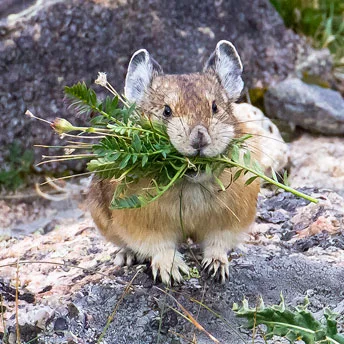From Climate Change to Plague, The American Pika Faces Many Environmental Obstacles
An American Pika builds its nest - www.nps.gov
Pikas are disappearing. This is bad news not only because they’re fuzzy and adorable, but because they’re also seen as a canary in the coal mine for global climate change. While many biologists are taking notice of this fading species, government agencies are slower to recognize the change.
The U.S. Fish and Wildlife Service recently rejected a petition to review the American pika’s status as a potentially endangered animal. In order to qualify as endangered, a species must experience a 50 to 70 percent decline, according to the Endangered Species Act.
Chris Ray, a biologist with INSTAAR, the Institute for Alpine and Arctic Research in Boulder, Colorado, emphasizes the importance of pikas not necessarily as an integral part of the high alpine ecosystem, but as a signal for changing climate.
“They’re not really a significant source of food for any predators, and they don’t really provide much for the environment,” said Ray, “but when the permafrost disappears, so do the pikas. And that means no more water.”
This is particularly bad news for places like Utah and California, both of which depend heavily on high-mountain permafrost and snow melt for municipal water. Similarly, Boulder scientists like Ray are keeping a close eye on Rocky Mountain pika populations as an indication of the future of Boulder’s water supply.
When pikas disappear, that’s a strong indication that permafrost too is about to fade away.
Chris Ray of INSTAAR nets a pika
"Pikas survival in the Rocky Mountains is a good indication as to their survival elsewhere" said Erika Garouette, a mammologist and pika specialist at the Denver Zoo.
Because of the specificity of their preferred temperatures, pika habitats are few and far between, leading to a 30-50% decline, according to the Front Range Pika Project, in some areas that falls just short of what is required in order to be considered endangered.
Pikas, a native Colorado species, are the smallest members of the rabbit family, and live in the talus slopes, or rocky patches of rock in high alpine environments such as the Rocky Mountains. These alpine critters evolved from Siberian ancestors that crossed the land bridge that once connected Alaska and Asia, and are dependent on cold and rocky slopes to survive. Pikas can die when exposed to temperatures as mild as 78 degrees, according to a study by INSTAAR, a problem exacerbated by a warming climate and retreating permafrost. Once mountains begin to warm, pikas can only retreat so far upslope, causing many populations to decline or disappear altogether.
Pikas need a dense blanket of snow to provide insulation for harsh mountain winters. Without dependable snow cover, pikas can’t weather the extreme cold of high alpine winters, nor can they tolerate the increasingly warm summers. This August, the U.S. Geological Survey conducted a study of pikas, and found that their population has dramatically decreased in areas of Utah and California, a decline that the USGS links to a warming climate. The U.S. Fish and Wildlife Service did not take the USGS’s most recent findings into account when considering the pika’s status
.
Luckily, Colorado populations are relatively robust. An extensive survey in 2008 by Colorado Parks and Wildlife examined 62 known pika habitats, and found that 90 percent of these habitats still supported healthy pika populations. While Colorado is not exempt from climate change, it does boast altitudes above 14,000 ft., making it an ideal place for cold-seeking pikas. Since the 2008 survey, Colorado Parks and Wildlife has documented upwards of 900 occupied habitats boasting healthy pika populations.
As for the future of the pika, Ray is relieved that they didn’t receive classification as an endangered species.
“It could be potentially disastrous to have them classified as endangered under the Endangered Species Act, because I don’t feel the ESA has the legislative teeth to help us protect the American pika by stopping global warming. I just don’t think that’s a viable tool,” Ray said.
That’s not to undermine the precariousness of the pikas situation, which is indeed dire. Populations in Utah, California and Oregon have decreased in numbers from 30 to 50 percent, according to the most recent USGS study. As mountain tops warm and talus slopes become too warm to support pikas, they have no retreat. Besides bringing attention to the issue, the Endangered Species Act has no real way to address the root of the issue—namely, global climate change.
Though many people are upset that pikas won’t be appearing on the Endangered Species List, a more holistic approach to pika conservation is required, and this review of the fuzzy critter’s status could serve as a wake up call to those unaware of the pika’s plight.

